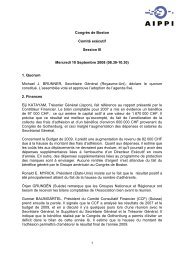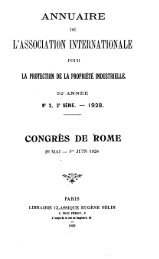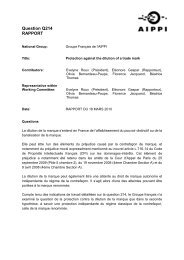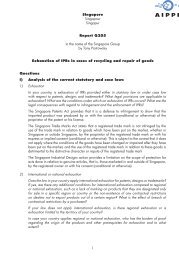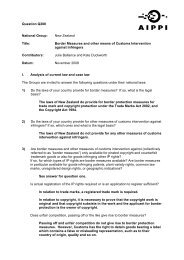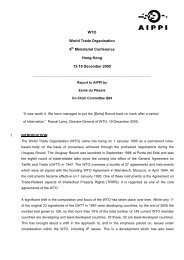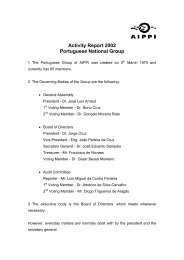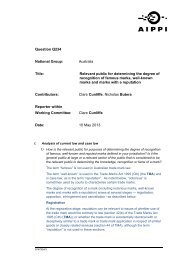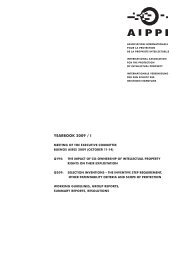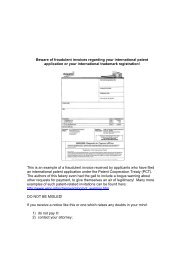Question Q217 - AIPPI
Question Q217 - AIPPI
Question Q217 - AIPPI
Create successful ePaper yourself
Turn your PDF publications into a flip-book with our unique Google optimized e-Paper software.
<strong>Question</strong> <strong>Q217</strong><br />
National Group:<br />
Japanese Group<br />
Title:<br />
The patentability criterion of inventive step / non-obviousness<br />
Contributors:<br />
Reporter within<br />
Working Committee:<br />
Takeshi AOKI, Katsuomi ISOGAI, Masahiro UMINO, Shimako<br />
KATO, Hiroshi KAMIYAMA, Hiroyuki SUDA, Kazuhiko TAMURA,<br />
Kiyoko NAKAOKA, Kenichi YAMAGUCHI、Nobutaka YOKOTA<br />
Yuzuru OKABE<br />
Date: 14 June 2011<br />
<strong>Question</strong>s<br />
I. Analysis of current law and case law<br />
The Groups are invited to answer the following questions under their national laws:<br />
Level of inventive step / non-obviousness<br />
1. What is the standard for inventive step / non-obviousness in your jurisdiction?<br />
How is it defined?<br />
(Answer)<br />
Such a definition is found in Article 29 (2) of the Patent Act (the underlined part below).<br />
In Paragraph (1) of this article, there are definitions of a patent that lacks novelty:<br />
(i) inventions that were publicly known in Japan or a foreign country, prior to the filing of the<br />
patent application;<br />
(ii) inventions that were publicly worked in Japan or a foreign country, prior to the filing of the<br />
patent application; or<br />
(iii) inventions that were described in a distributed publication, or inventions that were made<br />
publicly available through an electric telecommunication line in Japan or a foreign country,<br />
1
prior to the filing of the patent application.<br />
Then, Paragraph (2) provides "Where, prior to the filing of the patent application, a person<br />
ordinarily skilled in the art of the invention would have been able to easily make the<br />
invention based on an invention prescribed in any of the items of the preceding paragraph, a<br />
patent shall not be granted for such an invention notwithstanding the preceding paragraph."<br />
2. Has the standard changed in the last 20 years? Has the standard evolved with the<br />
technical / industrial evolution of your jurisdiction?<br />
(Answer)<br />
Not changed. However, there were modifications: adaptation of the criteria of publicly<br />
known / publicly worked inventions to the globalization and addition of the passage<br />
"inventions that were made publicly available through an electric telecommunication line"<br />
with the development of Internet in 1999.<br />
3. Does your patent-granting authority publish examination guidelines on inventive<br />
step / non-obviousness? If yes, how useful and effective are the guidelines?<br />
(Answer)<br />
Yes.<br />
The Patent Examination Guidelines provide a basic policy on application of the relevant laws<br />
such as the Patent Act that are considered the best at this time in order that examinations<br />
may be conducted in a fair, reasonable and efficient manner in accordance with certain<br />
standards. The Examination Guidelines have been widely used not only as criteria in<br />
examinations but also as a barometer of patent management, etc. by the applicants.<br />
Moreover, the Guidelines are useful for learning about criteria in specific technical fields.<br />
4. Does the standard for inventive step / non-obviousness differ during examination<br />
versus during litigation or invalidity proceedings?<br />
(Answer)<br />
The standard is the same.<br />
2
Construction of claims and interpretation of prior art<br />
5. How are the claims construed in your jurisdiction? Are they read literally, or as<br />
would be understood by a person skilled in the art?<br />
(Answer)<br />
Basically, the claims are read literally. When making a finding of a claimed invention,<br />
based on which inventive step is determined, the meanings of terms in the claims are<br />
construed as what they usually mean as technical terms (Examination Guidelines).<br />
6. Is it possible to read embodiments from the body of the specification into the<br />
claims?<br />
(Answer)<br />
A finding of a claimed invention, based on which inventive step is determined, is supposed<br />
to be made in the following manner (Supreme Court decision on "Lipase Case" in 1991):<br />
"For determination of the patentability requirements under Article 29 (1) and (2), namely,<br />
novelty and inventive step of a claimed invention, it is necessary to make a finding of the<br />
claimed invention that serves as a precondition for comparison with each of the inventions<br />
provided in the paragraph (1) of the same Article. This finding should be made based on<br />
the claims unless the circumstances are exceptional — for example, if the technological<br />
significance of the claims cannot be understood unambiguously or if the claims are<br />
obviously erroneous in the light of detailed description of the invention contained in the body<br />
of the specification. Only in such circumstances, the detailed description of the invention in<br />
the specification may be taken into consideration."<br />
Thus, under exceptional circumstances as mentioned above that it is possible to take into<br />
consideration the embodiments contained in the specification.<br />
7. How is the prior art interpreted? Is it read literally or interpreted as would be<br />
understood by a person skilled in the art? Is reliance on inherent disclosures<br />
(aspects of the prior art that are not explicitly mentioned but would be understood to<br />
be present by a person skilled in the art) permitted?<br />
(Answer)<br />
3
If prior art is disclosed in a publication, a finding of an invention related to the prior art is<br />
made on the basis of "matters described in a publication." Interpretation of the matters in a<br />
publication can be made in consideration of common technical knowledge of a person<br />
skilled in the art. Matters which a person skilled in the art can derive from the matters<br />
described in a publication in consideration of common technical knowledge as of the filing<br />
date can also be a basis for a finding of an invention disclosed in a publication. (Examination<br />
Guidelines)<br />
Reliance on inherent disclosures is permitted when making interpretation of prior art. For<br />
example, if a commercially-available reagent is disclosed in a publication and a specific<br />
physical property of this reagent is not described in that publication but it is understandable,<br />
from other documents such as a pamphlet, that such a physical property is present in this<br />
reagent, it becomes possible to make a finding of this physical property.<br />
8. Do the answers to any of the questions above differ during examination versus<br />
during litigation?<br />
(Answer)<br />
There is said to be a difference in to what extent it is allowed to take into consideration of the<br />
detailed description of invention contained in the specification between during examination<br />
(when making a finding of a claimed invention in relation to inventive step) and during<br />
infringement litigation.<br />
As a rule, in infringement litigation, claims shall be interpreted based on the statements in<br />
the scope of claims and the meaning of each term used in the scope of claims shall be<br />
interpreted in consideration of the statements in the specification and drawings (Article 70<br />
(1) and (2) of the Patent Act). In this way, it is thought that claims may be interpreted in<br />
consideration of the statements in the specification to a greater extent during litigation.<br />
Combination or modification of prior art<br />
9. Is it proper in your jurisdiction to find lack of inventive step or obviousness over a<br />
single prior art reference? If yes, and assuming the claim is novel over the prior art<br />
reference, what is required to provide the missing teaching(s)? Is argument<br />
sufficient? Is the level of the common general knowledge an issue to be considered?<br />
4
(Answer)<br />
It is possible to deny inventive step over a single prior art reference.<br />
The missing teachings may be covered by common technical knowledge, well-known art,<br />
design choice, etc. and it is necessary to prove (or disprove) them to be as such on a<br />
technical level.<br />
However, there are also cases where argument was sufficient to provide the missing<br />
teachings or where the court mentioned the number of documents needed to prove that a<br />
claimed invention is well known. Thus, we can also say it case by case basis.<br />
Also, lack of inventive step may be found when there are suggestions concerning the<br />
claimed invention in the contents of cited references. The level of the common general<br />
knowledge is considered, , as a precondition for the determination. Facts that are thought<br />
to be common knowledge of engineers in general will be taken into consideration in<br />
examinations of inventions in all technical fields. Facts that are thought to be common<br />
knowledge of engineers in a specific technical field will be taken into consideration in<br />
examinations of inventions in the relevant technical field.<br />
10. What is required to combine two or more prior art references? Is an explicit<br />
teaching or motivation to combine required?<br />
(Answer)<br />
When an explicit teaching or motivation is found in the references, it will be concluded<br />
that it was easy to combine the prior art references. The Examination Guidelines give<br />
examples of a motivation to combine two or more prior art references as follows:<br />
(1) Close relation of technical fields<br />
(2) Close similarity in problem to be solved<br />
(3) Close similarity in function, work or operation<br />
A judgment on whether it is an adequate motivation is made comprehensively by taking into<br />
account various elements such as the cited references, the technical field of the claimed<br />
invention, and the state of the art in that field.<br />
5
11. When two or more prior art references are combined, how relevant is the<br />
closeness of the technical field to what is being claimed? How relevant is the<br />
problem the inventor of the claim in question was trying to solve?<br />
(Answer)<br />
The closeness of the technical field to what is being claimed is relevant but not absolute.<br />
The problem the inventor of the claim in question was trying to solve is also relevant but no<br />
absolute.<br />
With an increase in the closeness of technical fields, a motivation to combine prior art<br />
references tends to be recognized more easily. A difference in the technical problem can<br />
be an obstructive factor for the combination.<br />
12. Is it permitted in your jurisdiction to combine more than two references to show<br />
lack of inventive step or obviousness? Is the standard different from when only two<br />
references are combined?<br />
(Answer)<br />
Yes. There is no difference, in particular, from when only two references are combined.<br />
However, in most of the cases where three or more references are used, one becomes a<br />
primary reference and the others are secondary references that will make up for missing<br />
elements in the primary reference.<br />
13. Do the answers to any of the questions above differ during examination versus<br />
during litigation?<br />
(Answer)<br />
No.<br />
Technical Problem<br />
14. What role, if any, does the technical problem to be solved play in determining<br />
inventive step or non-obviousness?<br />
(Answer)<br />
6
The technical problem can serve as a reason both for denying and accepting inventive step.<br />
For example, when there is a close similarity in the technical problem between the claimed<br />
and cited references or when the technical problem of the claimed invention is obvious to a<br />
person skilled in the art, the technical problem can be strong grounds for applying or<br />
combining cited inventions (Examination Guidelines).<br />
On the other hand, if the technical problem is not suggested in the cited references or it is<br />
not obvious to a person skilled in the art, there is a technical significance in the sense that<br />
advantageous effects is achieved by solving such a new technical problem. Therefore, the<br />
technical problem can be taken into consideration as a factor in acceptance of inventive<br />
step.<br />
15. To what degree, if any, must the technical problem be disclosed or identified in the<br />
specification?<br />
(Answer)<br />
A technical problem is taken into consideration when it is described in the specification.<br />
However, even if not described explicitly in the specification, it is possible that the technical<br />
problem may be found to the extent that it is obvious from relations with prior art or<br />
description in the specification and drawings.<br />
Advantageous effects<br />
16. What role, if any, do advantageous effects play in determining inventive step or<br />
non-obviousness?<br />
(Answer)<br />
If advantageous effects are more remarkable than what is expected from the state of the art,<br />
such effects will be taken into consideration as a factor in acceptance of inventive step.<br />
For example, "the inventive step should be positively inferred if a claimed invention has an<br />
advantageous effect, qualitatively different or qualitatively the same but quantitatively<br />
prominent in comparison with those of cited inventions, and if the advantageous effect<br />
cannot be predicted by a person skilled in the art from the state of the art.<br />
7
17. Must the advantageous effects be disclosed in the as-filed specification?<br />
(Answer)<br />
Since the advantageous effects are one of the factors considered in determination of<br />
inventive step, they must basically be described in the as-filed specification, and not be<br />
added later. However, for example, it is allowed to submit results of an experiment for<br />
comparison with the cited reference in order that such data may taken into consideration in<br />
determination of inventive step.<br />
18. Is it possible to have later-submitted data considered by the Examiner?<br />
(Answer)<br />
It is possible to submit data in a written argument in order to be considered by the Examiner.<br />
At least, however, advantageous effects asserted in a written argument must be something<br />
that is described in the as-filed specification or that can be inferred from description in the<br />
specification or drawings (Examination Guidelines). According to a court decision, if the<br />
specification contains description from which a person skilled in the art can infer the<br />
"advantageous effects," the applicant may submit experiment results later to assert inventive<br />
step.<br />
19. How "real" must the advantageous effects be? Are paper or hypothetical<br />
examples sufficient?<br />
(Answer)<br />
According to our opinion, how "real" the advantageous effects must be depends on how<br />
much emphasis is placed on these effects.<br />
For example, in the fields of chemistry and biotechnology where the degree of technical<br />
predictability is low, advantageous effects of an invention need to be actually verified; paper<br />
or hypothetical examples are considered insufficient.<br />
On the other hand, in the fields of machinery and electricity, emphasis is placed on whether<br />
the constitution of invention can be easily arrived at (conceived of), and sometimes paper or<br />
8
hypothetical examples are acceptable without any problems.<br />
20. Do the answers to any of the questions above differ during examination versus<br />
during litigation?<br />
(Answer)<br />
No.<br />
Teaching away<br />
21. Does your jurisdiction recognize teaching away as a factor in favor of inventive<br />
step / non-obviousness? Must the teaching be explicit?<br />
(Answer)<br />
Yes.<br />
According to the Examination Guidelines, "when there is such a description in a cited<br />
reference that precludes the claimed invention from being easily arrived at, this cited<br />
reference is not eligible for a primary prior art."<br />
It is not clear how teaching need to be provided so as to be recognized as an obstructive<br />
factor. However, it seems that, to be recognized as an obstructive factor in a practical<br />
sense, teachings need to be provided in such a way that a cited invention may be<br />
considered an obstructive factor which would actively cause a technical contradiction when<br />
applied.<br />
22. Among the other factors supporting inventive step / non-obviousness, how<br />
important is teaching away?<br />
(Answer)<br />
Teaching away can be a factor in acceptance of inventive step. However, it is one of the<br />
factors, like the technical problem and advantageous effects of invention, that are used for<br />
determination of inventive step. Inventive step of an invention is determined by<br />
comprehensively considering both the negative factors in inventive step (close similarity in<br />
problem to be solved, close relation of technical fields, close similarity in work or operation,<br />
etc.) and positive factors (remarkable effects, obstructive factors, etc.).<br />
9
23. Is there any difference in how teaching away is applied during examination versus<br />
in litigation?<br />
(Answer)<br />
No.<br />
Secondary considerations<br />
24. Are secondary considerations recognized in your jurisdiction?<br />
(Answer)<br />
Yes. The Examination Guidelines say, "A commercial success or other similar facts can be<br />
taken into consideration in order to support to affirmatively infer inventive step."<br />
However, there must be a close connection between the secondary considerations and the<br />
claimed invention. It is quite rare that such connection is accepted and the secondary<br />
considerations are recognized as a positive factor in inventive step.<br />
25. If yes, what are the accepted secondary considerations? How and to what<br />
degree must they be proven? Is a close connection between the claimed invention<br />
and the secondary considerations required?<br />
(Answer)<br />
[The following are considered as secondary considerations. However, this does not<br />
necessarily mean that there are cases where each of these considerations were recognized<br />
as a factor in acceptance of inventive step.]<br />
• Commercial success<br />
• State of not being achieved for a long time<br />
• Existence of many licenses<br />
[Proof of secondary considerations]<br />
It is necessary to be able to prove that a commercial success etc. was achieved on the basis<br />
of features of the invention.<br />
10
We give examples of court decision related to secondary considerations below. Actually,<br />
secondary considerations are not recognized in a predominant number of cases.<br />
• Commercial success<br />
There is a case where the court accepted inventive step, judging that the advantageous<br />
effects described in the specification and economic effects of the invention were obvious<br />
(Tokyo High Court decision in 1992).<br />
There is a case where the court denied inventive step, judging that a commercial success<br />
does not influence the predictability of effects of the invention (Tokyo High Court decision in<br />
1997).<br />
There is a case where the court denied inventive step, judging that even if a new product<br />
drives out an existing type of products from the market, it cannot necessarily be said that<br />
this is due to the superiority of the new product, because reasons for this also include the<br />
product's economical efficiency, design and marketing method, as well as the economic<br />
situation and other variables (Supreme Court decision in 1975).<br />
• State of not being achieved for a long time<br />
There is a case where the court accepted inventive step, pointing out the fact that the<br />
claimed invention had not actually been applied and its production was expected to be<br />
difficult (Tokyo High Court decision in 1971). In this case, the applicant sent out a<br />
questionnaire to people in the same trade, and the court recognized that their answers had<br />
probative value.<br />
There is a case where the court denied inventive step, judging that the state of not being<br />
arrived at (conceived of) for a long time or a commercial success does not influence the<br />
determination of conceivability of the claimed invention, regardless of whether it is true or<br />
not (Tokyo High Court decision in 2004).<br />
26. Do the answers to any of the questions above differ during examination versus<br />
during litigation?<br />
(Answer)<br />
No.<br />
11
Other considerations<br />
27. In addition to the subjects discussed in questions 4 - 26 above, are there other<br />
issues, tests, or factors that are taken into consideration in determining inventive<br />
step / non-obviousness in your jurisdiction? If yes, please describe these issues,<br />
tests, or factors.<br />
(Answer)<br />
There is not a particular test for determination of inventive step. However, the Examination<br />
Guidelines explains points to keep in mind (i.e. a policy) concerning a typical approach to<br />
determination of inventive step:<br />
(1) Selection of an optimal material, workshop modification of design<br />
The Examination Guidelines say, "Among exercises of ordinary creativity of a person skilled<br />
in the art are a selection of an optimal material from publicly known materials which achieve<br />
a specific object, an optimization of a numerical value range, a replacement with equivalents,<br />
and a workshop modification of design in applying specific technology. When the difference<br />
of a claimed invention in comparison falls only under these categories, it is usually<br />
considered that a person skilled in the art could have easily arrived at it, unless otherwise<br />
there is another ground for inferring inventive step."<br />
(2) Mere aggregation of features<br />
The Examination Guidelines say, "If matters defining an invention are not linked each other<br />
functionally or operationally and the invention is a combination of each matter (mere<br />
aggregation of features), the invention is deemed as a mere exercise of ordinary creativity of<br />
a person skilled in the art, unless otherwise there is another ground for inferring inventive<br />
step."<br />
(3) Elimination of hindsight<br />
Although not mentioned in the Examination Guidelines, there is a precedent where the court<br />
ruled that hindsight shall be eliminated (Intellectual Property High Court decision in 2008).<br />
Test<br />
12
28. What is the specific statement of the test for inventive step/non-obviousness in<br />
your jurisdiction? Is there jurisprudence or other authoritative literature interpreting<br />
the meaning of such test and, if so, provide a brief summary of such interpretation.<br />
(Answer)<br />
[Test for inventive step]<br />
According to the Examination Guidelines, inventive step is determined by performing the<br />
following procedure:<br />
(1) Finding of the claimed invention<br />
(2) Finding of cited inventions<br />
(3) Selection of one cited invention most suitable for the reasoning<br />
(4) Finding of identicalness and difference between the claimed invention and the primary<br />
cited invention<br />
(5) Decision on the difference<br />
- Whether the claimed invention falls under a selection of optimal material, a workshop<br />
modification of design, a mere juxtaposition of features on the basis of cited inventions;<br />
- Whether the contents of cited inventions disclose a cause or a motivation for a person<br />
skilled in the art to arrive at the claimed invention (any of (1) close relation of technical fields,<br />
(2) close similarity in problem to be solved, (3) close similarity in function, work or operation,<br />
and (4) suggestions shown in the contents of cited inventions); and<br />
- Whether the advantageous effects are greater than expected.<br />
Finally, determination of inventive step is made based on the evaluation of the above.<br />
According to a book (Commentaries on Patent Law by Nobuhiro Nakayama), inventive step<br />
is usually determined in a comprehensive manner through comparison with a publicly known<br />
invention in terms of the purpose, constitution and advantageous effects of the invention.<br />
This book says that there are three approaches: one that puts emphasis on the constitution,<br />
one that puts emphasis on the advantageous effects, and one that consider the three<br />
elements equally, although how each of these elements should be considered depends on<br />
the type of invention. Each of these approaches has advantages and disadvantages, but it<br />
13
is normal that inventive step is determined mainly based on the constitution of the invention,<br />
according to this book. It also explains that what is considered in making a determination<br />
of inventive step of an invention is the predictability and characteristics of its purpose, the<br />
predictability and difficulty of its constitution, and the predictability of its advantageous<br />
effects.<br />
[Literature that makes interpretation of meaning of test]<br />
Such articles and books abound, but most of them give explanations of the test for inventive<br />
step in accordance with the JPO's Examination Guidelines. There are not books or articles,<br />
in particular, that are considered the most authoritative.<br />
29. Does such test differ during examination versus during litigation?<br />
(Answer)<br />
The Examination Guidelines are used in determination of inventive step at the Japan Patent<br />
Office. However, past court cases are reflected in the Guidelines, and therefore, there is<br />
not a big difference in the test between examination and litigation.<br />
Patent granting authorities versus courts<br />
30. If there are areas not already described above where the approach to inventive<br />
step / non-obviousness taken during examination diverges from that taken by courts,<br />
please describe these areas.<br />
(Answer)<br />
No.<br />
31. Is divergence in approach to inventive step / non-obviousness between the courts<br />
and the patent granting authority in your jurisdiction problematic?<br />
(Answer)<br />
In 2000, a revision was made to the Examination Guidelines in relation to inventive step.<br />
The Supreme Court's decision on the "Kilby Case" in the same year made it possible for the<br />
court to rule on validity of patents in infringement cases. As a result, there was confusion<br />
due to variations in determination of inventive step between the court and the JPO, but<br />
14
thanks to efforts by all parties concerned, their decisions have become more consistent now.<br />
However, there is a problem of dual path, that is, a situation where a patent invalidation trial<br />
at the JPO is underway concurrently with a lawsuit on validity of the patent at the court.<br />
Now, to prevent a discrepancy in their decisions under such a situation, the invalidation trial<br />
is set to take precedence.<br />
Regional and national patent granting authorities<br />
32. If you have two patent granting authorities covering your jurisdiction, do they<br />
diverge in their approach to inventive step / non-obviousness?<br />
(Answer)<br />
We do not have such a problem.<br />
33. If yes, is this problematic?<br />
(Answer)<br />
We do not have such a problem.<br />
II. Proposals for harmonization<br />
The Groups are invited to put forward proposals for the adoption of harmonised rules<br />
in relation to the patentability criteria for inventive step / non-obviousness. More<br />
specifically, the Groups are invited to answer the following questions without regard<br />
to their national laws:<br />
34. Is harmonization of inventive step / non-obviousness desirable?<br />
(Answer)<br />
Yes. Harmonization should be achieved through typical, representative, and principled<br />
approaches.<br />
Many Japanese companies are actively working on the globalization of their business<br />
activities . In the globalized business activities, it is important that there be uniformity of<br />
eligibility for patents applied for by different companies in Japan and other major countries<br />
15
and that this eligibility be predictable.<br />
Work on the harmonization of inventive step / non-obviousness should be carried out based<br />
on the understanding of common goals such as a reduction of cost for obtaining a patent,<br />
the same level of quality of examinations at every Patent Office, rules on when to issue<br />
Office Action, etc.<br />
35. Is it possible to find a standard for inventive step / non-obviousness that would be<br />
universally acceptable?<br />
(Answer)<br />
It may be difficult but possible. To find a universally acceptable standard, it will be<br />
necessary to find out what is identical / different among the standards of various countries<br />
and then identify what are good / bad points of these standards. The problem of difference<br />
in difficulty level of inventive step standards exists especially between the developed and<br />
developing countries. We think, therefore, the developed countries (Trilateral IP Offices or<br />
IP5 (3 + China and Korea)) should initiate an effort to create a framework that may be<br />
extended to the other countries in the future.<br />
36. Please propose a definition for inventive step / non-obviousness that you would<br />
consider to be broadly acceptable.<br />
(Answer)<br />
Instead of a subjective concept such as "inventor's efforts" or an ambiguous one like "flash<br />
of creative genius" (US Supreme Court decision on Cuno Engineering v. Automatic Device<br />
Corp. in 1941), a definition needs to be able to serve as an objective evaluation standard.<br />
For example: Article 29 (2) of the Japanese Patent Act (whether a person ordinarily skilled in<br />
the art would have been able to easily make the invention), Section 103 of the US Patent<br />
Law (whether the subject matter would have been obvious to a person having ordinary skill<br />
in the art), or Article 56 of the European Patent Convention (whether it is obvious to a person<br />
skilled in the art). Any of the above would be sufficient to ensure objectivity as a definition.<br />
Whether such a definition becomes broadly acceptable will depend on how it is developed<br />
as a standard, not on what the definition is. If a unified standard is developed through a<br />
process approved by participant countries, then these members will have to adhere to it.<br />
We think, we can employ an ordinary standardization process or a decision-making /<br />
16
organizing process used in the EU and other communities.<br />
37. Please propose an approach to the application of this definition that could be<br />
used by examiners and by courts in determining inventive step / non-obviousness.<br />
(Answer)<br />
Effective approaches include: a problem-solution approach in Europe, a determination<br />
approach in the US adopted after the KSR decision, and an approach shown in the<br />
Examination Guidelines in Japan. Although they differ from one another, each of them is<br />
adequate in its own way. When operated properly by the examiners, it seems that there<br />
will not be a major difference in resulting decisions.<br />
First, the countries need to share policies and points to keep in mind concerning the typical<br />
approaches to determination of inventive step. Instead of only focusing on what a<br />
determination approach should be, it is necessary to apply specific cases to each of these<br />
approaches and compare the results.<br />
While conducting these case studies, it is necessary to check on points of concern, for<br />
example, whether there is a risk of an irrational finding or forced reasoning typically caused<br />
by hindsight, whether a high difficulty level of inventive step standard may lead to an<br />
extremely imbalanced operation, and whether there may be variations in the results among<br />
the examiners.<br />
Through the process described above, a more appropriate approach will be selected or<br />
created, we think.<br />
SUMMARY<br />
The inventive step criteria of Japan is stipulated in Article 29 paragraph 2 of the Patent<br />
law, which reads that “if an invention which would have been able to easily make based<br />
on prior arts, such an invention shall not be granted”. Also, the Japanese Patent Office<br />
(JPO) issues an examination guide line that is well used by the applicant and attorneys.<br />
As a practice of judgment of the inventive step, there is an established routine that (1)<br />
an invention and closest prior art are compared, (2) extract identicalness and<br />
differences between two arts and (3) judge if the differences can be easily overcome by<br />
17
an ordinaly o skilled in the art based on other evidences etc. Around the year 2,000, the<br />
examination guideline was revised and a supreme court decision ruled that a court<br />
handling a litigation can tell a validity of the patent in question. After this, validity<br />
standards between the court and JPO became inconsistent and some confusions<br />
occurred. However, such a confusion is now ceased and the judgments are stable.<br />
Currently, there are two different courses in the judgment of validity of the patent, i.e.<br />
invalidity trial before JPO and litigation in the court. This problem is called “double track<br />
problem” and there is an argument that such a double track situation is not favorable in<br />
view of the stability of the patent right.<br />
RÉSUMÉ<br />
Au Japon, le critère de l’activité inventive est stipulé à l’Article 29-2 de la Loi sur les<br />
brevets, qui indique que cette activité est absente si « l’homme du métier aurait pu<br />
réaliser l’invention facilement d’après la technique antérieure ». Par ailleurs, au titre de<br />
ses directives de jugement sur l’existence ou non d’activité inventive, l’Office japonais<br />
des brevets (JPO) publie des critères d’examen, et ceux-ci sont largement utilisés.<br />
Concernant la méthode de jugement de l’activité inventive, une pratique établie consiste<br />
à (1) comparer l’invention en question avec une invention citée, (2) extraire les points<br />
communs et différences entre les deux inventions, et (3) juger d’après d’autres preuves<br />
si ces différences étaient des points faciles à surmonter pour l’homme du métier. Les<br />
critères d’examen ont été révisés vers l’an 2000, et la Cour suprême a jugé que la<br />
validité d’un brevet (le jugement sur l’activité inventive ou non) peut être établie par un<br />
tribunal qui statue sur une contrefaçon. Cependant, une confusion est ainsi née entre<br />
l’Office des brevets et les tribunaux au sujet des critères de jugement de l’activité<br />
inventive, ce qui a appelé un débat. Il est toutefois considéré que la situation se stabilise<br />
à présent. Deux voies existent aujourd’hui pour juger de la validité d’un brevet (situation<br />
appelée « problème de la double voie ») : celle du jugement d’invalidité délivré par<br />
l’Office des brevets et celle du jugement d’un tribunal statuant sur la contrefaçon.<br />
Certaines critiques font remarquer que ceci nuit à la stabilité des décisions.<br />
ZUSAMMENFASSUNG<br />
Die Maßstäbe zur Beurteilung der erfinderischen Tätigkeit sind in Japan durch Art. 29<br />
18
Abs. 2 geregelt, wo es heißt, dass dann keine erfinderische Tätigkeit vorliegt, „wenn ein<br />
Durchschnittsfachmann auf dem Gebiet die Erfindung anhand des Stands der Technik<br />
leicht hätte tätigen können“. Das Patentamt hat die Prüfungskriterien veröffentlicht, die<br />
als Leitlinie zur Bestimmung des Vorliegens erfinderischer Tätigkeit dienen; sie finden<br />
breite Anwendung. Bei der Beurteilung der erfinderischen Tätigkeit hat sich eine Praxis<br />
etabliert, die folgende Schritte umfasst: (1) Vergleich zwischen der Erfindung und dem<br />
relevanten Stand der Technik, (2) Analyse der Übereinstimmungen und Abweichungen,<br />
(3) anhand weiterer Belege usw. eine Darlegung dessen, ob ein Durchschnittsfachmann<br />
die Abweichungen ohne Weiteres hätte überwinden können. Um das Jahr 2000 wurden<br />
die Prüfungskriterien überarbeitet; außerdem ermöglichte ein Urteil des Obersten<br />
Gerichtshofs es Gerichten, die sich mit Verletzungsklagen befassten, über die Gültigkeit<br />
eines Patents (der erfinderischen Tätigkeit) zu befinden. Dies schuf Unklarheiten in<br />
Bezug auf die jeweiligen Beurteilungskriterien von Patentamt und Gerichten und führte<br />
zu einigen Diskussionen; heute hat sich die Lage jedoch im Wesentlichen stabilisiert.<br />
Gegenwärtig stehen hinsichtlich der Beurteilung der erfinderischen Tätigkeit zwei Wege<br />
offen, nämlich zum einen eine Nichtigkeitsklage über das Patentamt und zum anderen<br />
ein Urteil durch ein Gericht, das eine Verletzungsklage bearbeitet (das so genannte<br />
Doppelwegproblem), weshalb kritische Stimmen Ungleichmäßigkeiten in der<br />
Beurteilung beklagen.<br />
19



